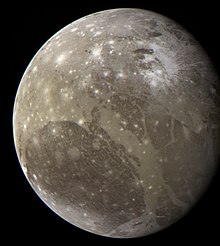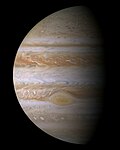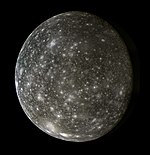This is an old revision of this page, as edited by A Quest For Knowledge (talk | contribs) at 11:44, 27 February 2024 (Removed time from launch date in lede. This level of detail isn't needed in the article summary.). The present address (URL) is a permanent link to this revision, which may differ significantly from the current revision.
Revision as of 11:44, 27 February 2024 by A Quest For Knowledge (talk | contribs) (Removed time from launch date in lede. This level of detail isn't needed in the article summary.)(diff) ← Previous revision | Latest revision (diff) | Newer revision → (diff) European Space Agency spacecraft For the proposed NASA spacecraft, see Jupiter Icy Moons Orbiter.
 Artist's impression of the Juice spacecraft Artist's impression of the Juice spacecraft | |||||||||||||||||||||||
| Names | Juice, JUICE | ||||||||||||||||||||||
|---|---|---|---|---|---|---|---|---|---|---|---|---|---|---|---|---|---|---|---|---|---|---|---|
| Mission type | Planetary science | ||||||||||||||||||||||
| Operator | ESA | ||||||||||||||||||||||
| COSPAR ID | 2023-053A | ||||||||||||||||||||||
| SATCAT no. | 56176 | ||||||||||||||||||||||
| Mission duration | Cruise phase: 8 years Science phase: 3.5 years Elapsed: 1 year, 9 months and 9 days | ||||||||||||||||||||||
| Spacecraft properties | |||||||||||||||||||||||
| Manufacturer | Airbus Defence and Space | ||||||||||||||||||||||
| Launch mass | 6,070 kg (13,380 lb) | ||||||||||||||||||||||
| Dry mass | 2,420 kg (5,340 lb) | ||||||||||||||||||||||
| Dimensions | 16.8 x 27.1 x 13.7 meters | ||||||||||||||||||||||
| Power | 850 watts from a solar panel ~85 m (910 sq ft) | ||||||||||||||||||||||
| Start of mission | |||||||||||||||||||||||
| Launch date | 14 April 2023 12:14:36 UTC | ||||||||||||||||||||||
| Rocket | Ariane 5 ECA | ||||||||||||||||||||||
| Launch site | Centre Spatial Guyanais, ELA-3 | ||||||||||||||||||||||
| Contractor | Arianespace | ||||||||||||||||||||||
| Flyby of Moon | |||||||||||||||||||||||
| Closest approach | 19 August 2024 | ||||||||||||||||||||||
| Flyby of Earth | |||||||||||||||||||||||
| Closest approach | 20 August 2024 | ||||||||||||||||||||||
| Flyby of Venus | |||||||||||||||||||||||
| Closest approach | 31 August 2025 | ||||||||||||||||||||||
| Flyby of Earth | |||||||||||||||||||||||
| Closest approach | 29 September 2026 | ||||||||||||||||||||||
| Flyby of Earth | |||||||||||||||||||||||
| Closest approach | 18 January 2029 | ||||||||||||||||||||||
| Jupiter orbiter | |||||||||||||||||||||||
| Orbital insertion | July 2031 (planned) | ||||||||||||||||||||||
| Orbital departure | December 2034 (planned) | ||||||||||||||||||||||
| Ganymede orbiter | |||||||||||||||||||||||
| Orbital insertion | December 2034 (planned) | ||||||||||||||||||||||
| Orbital parameters | |||||||||||||||||||||||
| Periapsis altitude | 500 km (310 mi) | ||||||||||||||||||||||
| Apoapsis altitude | 500 km (310 mi) | ||||||||||||||||||||||
| |||||||||||||||||||||||
| [REDACTED] Juice mission insignia Cosmic Vision← EuclidSMILE → | |||||||||||||||||||||||
The Jupiter Icy Moons Explorer (Juice, formerly JUICE) is an interplanetary spacecraft that was launched on 14 April 2023 from Guiana Space Centre in the French Guiana by the European Space Agency (ESA) with Airbus Defence and Space as the main contractor. The mission is planned to study Ganymede, Callisto, and Europa, three of Jupiter's Galilean moons. They are thought to have significant bodies of liquid water beneath their icy surfaces which would make them potentially habitable environments.
The spacecraft was launched on 14 April 2023 and is expected to reach Jupiter in July 2031 after four gravity assists and eight years of travel. In December 2034, the spacecraft will enter orbit around Ganymede for its close-up science mission. Its period of operations will overlap with NASA's Europa Clipper mission, launching in 2024.
Background
The mission, started as a reformulation of the Jupiter Ganymede Orbiter proposal, which was to be ESA's component of the cancelled Europa Jupiter System Mission – Laplace (EJSM-Laplace). It became a candidate for the first L-class mission (L1) of the ESA Cosmic Vision Programme, and its selection was announced on 2 May 2012.
In April 2012, JUICE was recommended over the proposed Advanced Telescope for High Energy Astrophysics (ATHENA) X-ray telescope and a gravitational wave observatory (New Gravitational wave Observatory (NGO)).
In July 2015, Airbus Defence and Space was selected as the prime contractor to design and build the probe, to be assembled in Toulouse, France.
By 2023, the mission was estimated to cost ESA 1.5 billion euros ($1.6 billion).
Spacecraft
The main spacecraft design drivers are related to the large distance to the Sun, the use of solar power, and Jupiter's harsh radiation environment. The orbit insertions at Jupiter and Ganymede and the large number of flyby manoeuvres (more than 25 gravity assists, and two Europa flybys) require the spacecraft to carry about 3,000 kg (6,600 lb) of chemical propellant.
Juice has a fixed 2.5 meter diameter high-gain antenna and a steerable medium-gain antenna, both X- and K-band will be used. Downlink rates of 2 Gb/day are possible with ground-based Deep Space Antennas. On-board data storage capability is 1.25 Tb.
The Juice main engine is a hypergolic bi-propellant (mono-methyl hydrazine and mixed oxides of nitrogen) 425 N thruster. A 100 kg multilayer insulation provides thermal control. The spacecraft is 3-axis stabilized using momentum wheels. Radiation shielding is used to protect onboard electronics from the Jovian environment.
The Juice science payload has a mass of 280 kg and includes the JANUS camera system, the MAJIS visible and infrared imaging spectrometer, the UVS ultraviolet imaging spectrograph, RIME radar sounder, GALA laser altimeter, SWI submillimetre wave instrument, J-MAG magnetometer, PEP particle and plasma package, RPWI radio and plasma wave investigation, 3GM radio science package, the PRIDE radio science instrument, and the RADEM radiation monitor. A 10.6-meter deployable boom will hold J-MAG and RPWI, a 16-meter-long deployable antenna will be used for RIME. Four 3-meter booms carry parts of the RPWI instrument. The other instruments are mounted on the spacecraft body, or for 3GM, within the spacecraft bus.
Timeline
Launch

Juice was launched into space on 14 April 2023 from the Guiana Space Centre on an Ariane 5 rocket. This was the final launch of an ESA science mission using the Ariane 5 vehicle, and was the second to last launch of the rocket overall.
The launch was originally scheduled for 13 April 2023, but due to poor weather the launch was postponed. The next day a second launch attempt succeeded, with liftoff occurring at 12:14:36 UTC. After the spacecraft separated from the rocket, it established a successful radio signal connection with the ground at 13:04 UTC. Juice's solar arrays were deployed about half an hour later, prompting ESA to deem the launch a success.
Trajectory
Following the launch, there will be multiple planned gravity assists to put Juice on a trajectory to Jupiter: a flyby of the Earth–Moon system in August 2024, Venus in August 2025, second flyby of Earth in September 2026, and a third and final flyby of Earth in January 2029.
Juice will pass through the asteroid belt twice. A flyby of the asteroid 223 Rosa was proposed to occur in October 2029, but was abandoned to save fuel for the primary Jovian mission.
Gravity assists include:
- Interplanetary transfer (Earth, Venus, Earth, Earth)
- Jupiter orbit insertion and apocentre reduction with multiple Ganymede gravity assists
- Reduction of velocity with Ganymede–Callisto assists
- Increase inclination with 10–12 Callisto gravity assists
 Around the Sun
Around the Sun Around Jupiter
Around Jupiter Around Ganymede Sun · Earth · Juice · Venus · 223 Rosa · Jupiter · Ganymede · Callisto · Europa
Around Ganymede Sun · Earth · Juice · Venus · 223 Rosa · Jupiter · Ganymede · Callisto · Europa
Arrival at the Jovian system
When it arrives in Jupiter's system in July 2031, Juice will first perform a flyby of Ganymede in preparation for Jupiter orbital insertion about 7.5 hours later. The first orbit will be elongated, with subsequent orbits gradually lowered over time, resulting in a circular orbit around Jupiter.
The first Europa flyby will take place in July 2032. Juice will enter a high inclination orbit to allow exploration of Jupiter's polar regions and to study Jupiter's magnetosphere.
Orbital insertion on Ganymede
In December 2034, Juice will enter an elliptical orbit around Ganymede. The first orbit will be at a distance of 5,000 km (3,100 mi). In 2035, JUICE will enter a circular orbit 500 km (310 mi) above the surface of Ganymede. Juice will study Ganymede's composition and magnetosphere among other things.
Planned deorbit on Ganymede
When the spacecraft consumes its remaining propellant, Juice is planned to be deorbited and impact Ganymede at the end of 2035.
Science objectives


The JUICE orbiter will perform detailed investigations on Ganymede and evaluate its potential to support life. Investigations of Europa and Callisto will complete a comparative picture of these Galilean moons. The three moons are thought to harbour internal liquid water oceans, and so are central to understanding the habitability of icy worlds.
The main science objectives for Ganymede, and to a lesser extent for Callisto, are:
- Characterization of the ocean layers and detection of putative subsurface water reservoirs
- Topographical, geological and compositional mapping of the surface
- Study of the physical properties of the icy crusts
- Characterization of the internal mass distribution, dynamics and evolution of the interiors
- Investigation of Ganymede's tenuous atmosphere
- Study of Ganymede's intrinsic magnetic field and its interactions with the Jovian magnetosphere.
For Europa, the focus is on the chemistry essential to life, including organic molecules, and on understanding the formation of surface features and the composition of the non-water-ice material. Furthermore, JUICE will provide the first subsurface sounding of the moon, including the first determination of the minimal thickness of the icy crust over the most recently volcanically active regions.
More distant spatially resolved observations will also be carried out for several minor irregular satellites and the volcanically active moon Io.
Science instruments

On 21 February 2013, after a competition, 11 science instruments were selected by ESA, which were developed by science and engineering teams from all over Europe, with participation from the US. Japan also contributed several components for SWI, RPWI, GALA, PEP, JANUS and J-MAG instruments, and will facilitate testing.
- Jovis, Amorum ac Natorum Undique Scrutator (JANUS)
The name is Latin for "comprehensive observation of Jupiter, his love affairs and descendants." A camera system to image Ganymede and interesting parts of the surface of Callisto at better than 400 m/pixel (resolution limited by mission data volume). Selected targets will be investigated in high-resolution with a spatial resolution from 25 m/pixel down to 2.4 m/pixel with a 1.3° field of view. The camera system has 13 panchromatic, broad and narrow-band filters in the 0.36 µm to 1.1 µm range, and provides stereo imaging capabilities. JANUS will also allow relating spectral, laser and radar measurements to geomorphology and thus will provide the overall geological context.
- Moons and Jupiter Imaging Spectrometer (MAJIS)
A visible and infrared imaging spectrograph operating from 400 nm to 5.70 µm, with spectral resolution of 3–7 nm, that will observe tropospheric cloud features and minor gas species on Jupiter and will investigate the composition of ices and minerals on the surfaces of the icy moons. The spatial resolution will be down to 75 m (246 ft) on Ganymede and about 100 km (62 mi) on Jupiter.
- UV Imaging Spectrograph (UVS)
An imaging spectrograph operating in the wavelength range 55–210 nm with spectral resolution of <0.6 nm that will characterise exospheres and aurorae of the icy moons, including plume searches on Europa, and study the Jovian upper atmosphere and aurorae. Resolution up to 500 m (1,600 ft) observing Ganymede and up to 250 km (160 mi) observing Jupiter.
- Sub-millimeter Wave Instrument (SWI)
A spectrometer using a 30 cm (12 in) antenna and working in 1080–1275 GHz and 530–601 GHz with spectral resolving power of ~10 that will study Jupiter's stratosphere and troposphere, and the exospheres and surfaces of the icy moons.
- Ganymede Laser Altimeter (GALA)
A laser altimeter with a 20 m (66 ft) spot size and 10 cm (3.9 in) vertical resolution at 200 km (120 mi) intended for studying topography of icy moons and tidal deformations of Ganymede.
- Radar for Icy Moons Exploration (RIME)

An ice-penetrating radar working at frequency of 9 MHz (1 and 3 MHz bandwidth) emitted by a 16 m (52 ft) antenna; will be used to study the subsurface structure of Jovian moons down to 9 km (5.6 mi) depth with vertical resolution up to 30 m (98 ft) in ice.
During post-launch commissioning of the spacecraft, the RIME antenna failed to properly deploy from its mounting bracket. After several weeks of attempts to free the instrument, it was successfully deployed on 12 May.
- JUICE-Magnetometer (J-MAG)

JUICE will study the subsurface oceans of the icy moons and the interaction of Jovian magnetic field with the magnetic field of Ganymede using a sensitive magnetometer.
- Particle Environment Package (PEP)
A suite of six sensors to study the magnetosphere of Jupiter and its interactions with the Jovian moons. PEP will measure positive and negative ions, electrons, exospheric neutral gas, thermal plasma and energetic neutral atoms present in all domains of the Jupiter system from 1 meV to 1 MeV energy.
- Radio and Plasma Wave Investigation (RPWI)
RPWI will characterise the plasma environment and radio emissions around the spacecraft, it is composed of four experiments: GANDALF, MIME, FRODO and JENRAGE. RPWI will use four Langmuir probes, each one mounted at the end of its own dedicated boom, and sensitive up to 1.6 MHz to characterize plasma and receivers in the frequency range 80 kHz to 45 MHz to measure radio emissions. This scientific instrument is somewhat notable for using Sonic the Hedgehog as part of its logo.
- Gravity and Geophysics of Jupiter and Galilean Moons (3GM)
3GM is a radio science package comprising a Ka transponder and an ultrastable oscillator. 3GM will be used to study the gravity field – up to degree 10 – at Ganymede and the extent of internal oceans on the icy moons, and to investigate the structure of the neutral atmospheres and ionospheres of Jupiter (0.1 – 800 mbar) and its moons.
- Planetary Radio Interferometer and Doppler Experiment (PRIDE)
The experiment will generate specific signals transmitted by JUICE's antenna and received by very-long-baseline interferometry to perform precision measurements of the gravity fields of Jupiter and its icy moons.
See also
- Exploration of Jupiter
- Europa Clipper – NASA space mission en route to Jupiter and Europa
- Galileo – former Jupiter orbiter
- Juno – current Jupiter orbiter
- Tianwen 4 – Planned Jupiter/Callisto orbiter
- Jupiter flybys: Pioneer 10 / 11; Voyager 1 / 2; Ulysses; Cassini–Huygens; New Horizons
- 17776, a speculative fiction work featuring a sapient JUICE
References
- ^ "NASA – NSSDCA – Spacecraft – Details". NASA Space Science Data Coordinated Archive. Archived from the original on 10 November 2021. Retrieved 16 April 2023.
 This article incorporates text from this source, which is in the public domain.
This article incorporates text from this source, which is in the public domain.
- ^ "European Space Agency: Blast off for Jupiter icy moons mission". BBC News. 14 April 2023. Archived from the original on 14 April 2023. Retrieved 14 April 2023.
- "Juice, exploring Jupiter's icy moons". The Planetary Society. Retrieved 30 April 2023.
- "ESA's Juice lifts off on quest to discover secrets of Jupiter's icy moons". ESA. Archived from the original on 14 April 2023. Retrieved 16 April 2023.
- "JUICE. Searching for life on Jupiter's icy moons". www.airbus.com. Archived from the original on 13 April 2023. Retrieved 16 April 2023.
- Clark, Stuart (5 March 2023). "'It's like finding needles in a haystack': the mission to discover if Jupiter's moons support life". The Guardian. Archived from the original on 7 March 2023. Retrieved 7 March 2023.
- "ESA—Selection of the L1 mission" (PDF). ESA. 17 April 2012. Archived (PDF) from the original on 16 October 2015. Retrieved 19 April 2012.
- ^ "Juice's journey and Jupiter system tour". ESA. 29 March 2022. Archived from the original on 24 September 2022. Retrieved 3 April 2022.
- "JUpiter ICy moons Explorer (JUICE)". NASA Space Science Data Coordinated Archive. NASA. 28 October 2021. Archived from the original on 10 November 2021. Retrieved 10 November 2021.
- "JUICE (JUpiter ICy moons Explorer): a European-led mission to the Jupiter system" (PDF). Copernicus.org. Archived (PDF) from the original on 21 November 2011. Retrieved 8 August 2011.
- Amos, Jonathan (2 May 2012). "ESA selects 1bn-euro Juice probe to Jupiter". BBC News. Archived from the original on 11 May 2020. Retrieved 20 June 2018.
- Lakdawalla, Emily (18 April 2012). "JUICE: Europe's next mission to Jupiter?". The Planetary Society. Archived from the original on 1 May 2012. Retrieved 2 May 2012.
- Amos, Jonathan (19 April 2012). "Disappointed astronomers battle on". BBC News. Archived from the original on 18 June 2019. Retrieved 20 June 2018.
- "Preparing to build ESA's Jupiter mission". ESA Science & Technology. European Space Agency. 17 July 2015. Archived from the original on 2 October 2015. Retrieved 28 October 2015.
- Europe’s Jupiter-bound JUICE spacecraft is ready for April launch Jan 2023
- "JUICE—Spacecraft". ESA Science & Technology. European Space Agency. 16 March 2012. Archived from the original on 10 May 2013. Retrieved 20 April 2012.
- ^ "ESA's Juice lifts off on quest to discover secrets of Jupiter's icy moons". ESA. 14 April 2023. Archived from the original on 14 April 2023. Retrieved 14 April 2023.
- Foust, Jeff (14 April 2023). "Ariane 5 launches ESA's JUICE mission to Jupiter". SpaceNews. Retrieved 18 April 2023.
- @Arianespace (13 April 2023). "Today's Flight #VA260 has been delayed due to weather condition (risk of lightning) at the scheduled liftoff time from Europe's Spaceport in French Guiana. The Ariane 5 launch vehicle and its passenger JUICE are in stable and safe condition" (Tweet). Retrieved 16 April 2023 – via Twitter.
- Avdellidou, C.; Pajola, M.; Lucchetti, A.; Agostini, L.; Delbo, M.; Mazzotta Epifani, E.; Bourdelle De Micas, J.; Devogèle, M.; Fornasier, S.; Van Belle, G.; Bruot, N.; Dotto, E.; Ieva, S.; Cremonese, G.; Palumbo, P. (2021). "Characterisation of the main belt asteroid (223) Rosa" (PDF). Astronomy & Astrophysics. 656: L18. Bibcode:2021A&A...656L..18A. doi:10.1051/0004-6361/202142600. S2CID 244753425.
- Warren, Haygen (20 March 2023). "As launch approaches, JUICE project manager discusses trajectories and science". NASASpaceFlight.com. Archived from the original on 12 April 2023. Retrieved 12 April 2023.
- European Space Agency (14 December 2023). "🧃 Time for another visit to the #ESAJuice bar 😉 At 8⃣% of the way to Jupiter, we have an update on our journey. We had been considering slightly diverting Juice to visit an asteroid en route to #Jupiter. To maximise fuel for our main mission (the tour around the gas giant and its icy moons), we have decided against this asteroid flyby" (Tweet) – via Twitter.
- "JUICE (JUpiter ICy moons Explorer)" (PDF). Universities Space Research Association. European Space Agency. March 2012. Archived (PDF) from the original on 9 January 2014. Retrieved 18 July 2013.
- ^ "JUICE—Science objectives". ESA Science & Technology. European Space Agency. 16 March 2012. Archived from the original on 8 June 2013. Retrieved 20 April 2012.
- "ESA chooses instruments for its Jupiter Icy Moon Explorer". ESA Science & Technology. ESA. 21 February 2013. Archived from the original on 1 November 2013. Retrieved 17 June 2013.
- "JUICE science payload". ESA Science & Technology. European Space Agency. 7 March 2013. Archived from the original on 22 April 2014. Retrieved 24 March 2014.
- "The JUICE Instruments". National Centre for Space Studies. 11 November 2013. Archived from the original on 24 March 2014. Retrieved 24 March 2014.
- "Jupiter Icy Moons Explorer (JUICE): Science objectives, mission and instruments" (PDF). Universities Space Research Association. 45th Lunar and Planetary Science Conference (2014). Archived (PDF) from the original on 24 March 2014. Retrieved 24 March 2014.
- "JUICE-JAPAN". JAXA. Archived from the original on 14 July 2020. Retrieved 14 July 2020.
- Saito, Y.; Sasaki, S.; Kimura, J.; Tohara, K.; Fujimoto, M.; Sekine, Y. (1 December 2015). "Current Status of Japanese Participation to Jupiter Icy Moons Explorer "JUICE"". AGU Fall Meeting Abstracts. 2015: P11B–2074. Bibcode:2015AGUFM.P11B2074S. Archived from the original on 14 April 2023. Retrieved 10 November 2019.
- "木星氷衛星探査衛星 JUICE – 日本が JUICE で目指すサイエンス" [Jupiter Ice Moon Exploration Satellite JUICE – Science that Japan is aiming for with JUICE] (PDF). JAXA. Archived from the original (PDF) on 12 November 2019. Retrieved 14 April 2023.
- Köhler, Ulrich (December 2021). "Of Distant Moons and Oceans" (PDF). German Aerospace Center. pp. 34–37. Archived (PDF) from the original on 26 May 2022. Retrieved 13 August 2022.
- "Work continues to deploy Juice RIME antenna". www.esa.int. Retrieved 5 May 2023.
- "Juice's RIME antenna breaks free". www.esa.int. Retrieved 12 May 2023.
- "木星氷衛星探査機に搭載の電波観測装置が「ソニック・ザ・ヘッジホッグ」と共に木星へ" [Radio observation equipment installed in the Jupiter ice satellite probe goes to Jupiter with 'Sonic the Hedgehog']. Tohoku University. Archived from the original on 21 January 2023. Retrieved 21 January 2023.
- Plunkett, Luke (3 October 2019). "Actual Space Mission Picks Sonic The Hedgehog As An Official Mascot". Kotaku. Archived from the original on 3 October 2019. Retrieved 21 January 2023.
- Shapira, Aviv; Stern, Avinoam; Prazot, Shemi; Mann, Rony; Barash, Yefim; Detoma, Edoardo; Levy, Benny (2016). "An Ultra Stable Oscillator for the 3GM experiment of the JUICE mission". 2016 European Frequency and Time Forum (EFTF). pp. 1–5. doi:10.1109/EFTF.2016.7477766. ISBN 978-1-5090-0720-2. S2CID 2489857.
External links
- ESA's JUICE page
- Future Planetary Exploration JUICE – Jupiter Ganymede Orbiter Revised Proposal
- Jupiter Icy Moons Explorer (2011) (OPAG October 2011 Presentations)
- JUICE (JUpiter ICy moons Explorer) (OPAG March 2012 Presentations)
- JUICE-JAPAN – JAXA
- JUICE – NASA
- JUICE article on eoPortal by ESA
- YouTube channel the making of JUICE – ESA
| Spacecraft missions to Jupiter | ||
|---|---|---|
| Flybys |  | |
| Orbiters | ||
| Atmospheric probes | ||
| En route |
| |
| Planned missions |
| |
| Proposed missions |
| |
| Cancelled or not developed | ||
| Related topics | ||
| Missions are ordered by launch date. Sign indicates failure en route or before intended mission data returned. indicates use of the planet as a gravity assist en route to another destination. | ||










